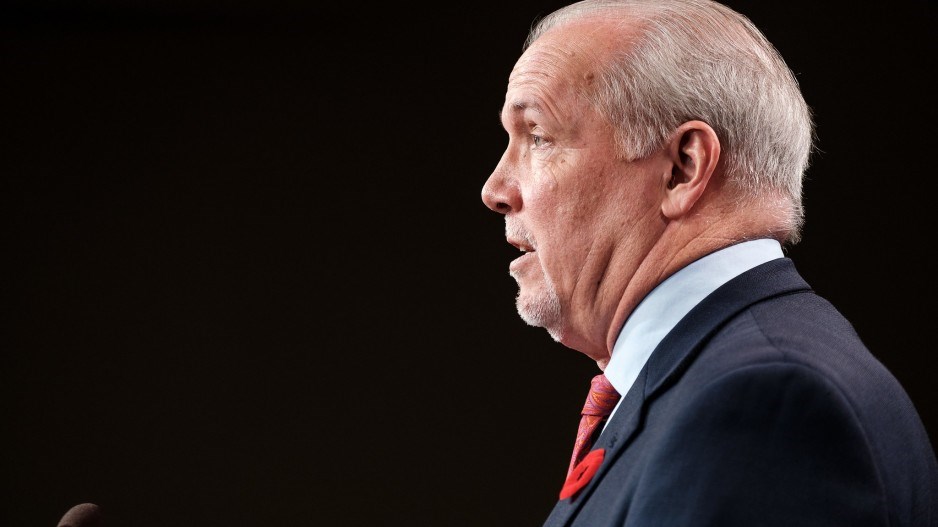A turning point in John Horgan’s five-and-a-half years as British Columbia premier came Sept. 21, 2020, when he announced a snap election between the first and second waves of the COVID-19 pandemic.
It appeared ill-timed and opportunistic. On day one of the campaign, Horgan famously justified breaking the fixed-election-date law and prematurely ending the NDP minority government’s confidence and supply deal with the BC Green Party by claiming the “best way forward is to put the politics behind us.”
Why was Horgan so confident? It turns out he had a roadmap for victory.
Specifically, he possessed the knowledge of what voters were thinking about the issues that concerned them, thanks to daily polling reports for cabinet that were originally intended to shape the NDP government’s response to the pandemic.
Nearly 6,000 pages obtained via freedom of information law include two dozen reports by NDP polling firm Strategic Communications Inc., also known as Stratcom, spanning April 23, 2020 to May 29, 2020. The records provide insight into how influential Stratcom has been in affirming the government’s policies and priorities.
The governing party, through Government Communications and Public Engagement (GCPE), gave Stratcom the no-bid, emergency contract less than a month after the pandemic began, worth almost $95,000 for “daily tracking polling regarding the COVID-19 pandemic in B.C.” The insights gleaned helped embolden the NDP as the legislature reconvened and campaign workers began to train for an election like no other.
Vancouver-headquartered Stratcom has a long history of working with the NDP and its once-powerful civic affiliate, Vision Vancouver. Clients include a who’s who of Canadian labour and environmental circles, from the David Suzuki Foundation and Greenpeace, to the Canadian Labour Congress, Unifor, BC General Employees’ Union and the United Steelworkers. Stratcom boasts offices in Toronto, Ottawa and two in the United Kingdom, where it works with the Labour Party.
When David Eby was sworn in Nov. 18, the six-foot-seven new premier said he wasn’t as tall as he looks, “because I’m standing on the shoulders of John Horgan.”
He could have said he was also standing on the shoulders of Stratcom. Not only is the company instrumental in the NDP’s power, but Eby’s right-hand man is Stratcom’s former president Matt Smith.
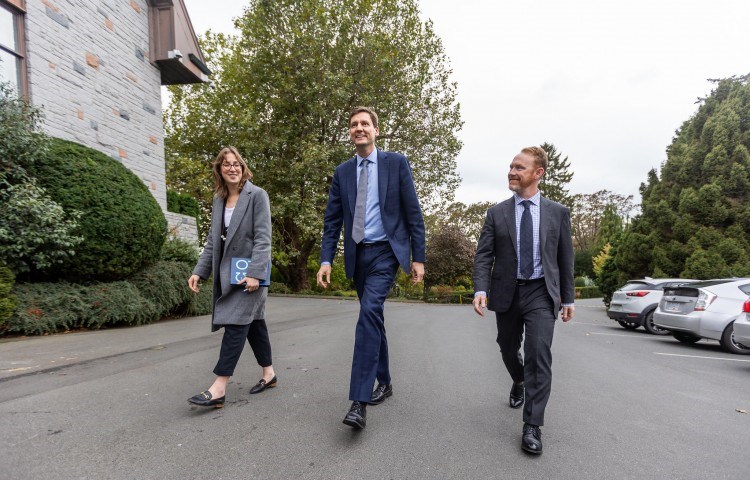
The COVID-19 Daily Tracking Polling project not only gauged public opinion on how the government was handling the pandemic and how citizens were affected, but also measured a long list of other issues that preceded the public health emergency.
In an affidavit to the Office of the Information and Privacy Commissioner (OIPC), in defence of withholding some information from the Stratcom disclosure, former Horgan press secretary Jen Holmwood explained the files include survey questions, options for response, topline reports highlighting the most important details and insights, and cross-tabulation reports, showing the relationship between survey questions.
“GCPE works with third-party public opinion research agencies to engage British Columbians and gain insights through qualitative and quantitative methods to aid in the development of marketing and advertising, and gather feedback [on] a variety of topical issues, as well as government policies and programs British Columbians rely on,” said Holmwood, now executive lead for corporate priorities in GCPE. “Strategic Communications Inc. is one of these research agencies.”
The last report, dated June 2, 2020, summarized Stratcom’s May 25-29 online poll, which sampled 924 B.C. residents, aged 18 and up. It was statistically weighted to match the gender, age and region of respondents – even the proportion of Chinese mother tongue in B.C., as per the 2016 census.
The names of four Stratcom executives – CEO Bob Penner, vice-president Stephanie Lynn, senior manager of research Armand Cousineau and data analyst Prathit Patel – were on the cover. Charts and graphs analyzed responses to 21 questions, broken down by the province’s four main regions and further broken down by eight sub-regions.
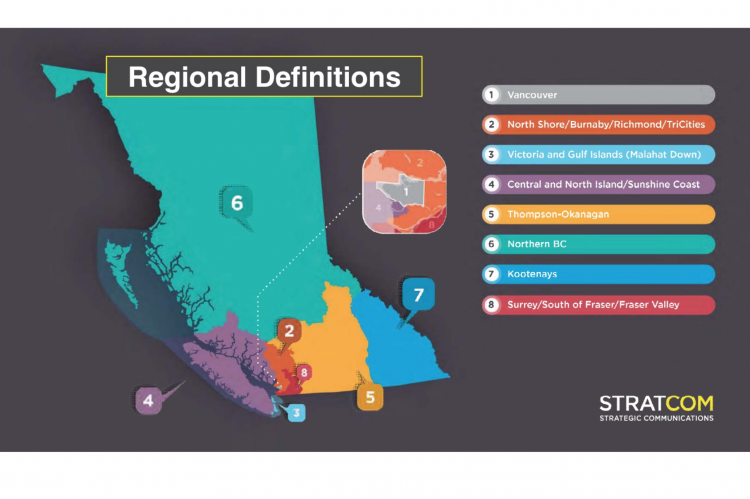
Stratcom asked respondents to choose the top two issues facing the province from a list of 24. It was no surprise what topped the list through the spring. By the end of May 2020, however, the proportion of respondents picking COVID-19 in their top two issues had fallen to 42 per cent, from a high of 66 per cent in March.
“Other top issues are cost of living/affordability (28 per cent), economy/jobs (20 per cent), and housing/price of real estate (18 per cent),” the report said. “These other top issues have remained consistent since the tracking polling started.”
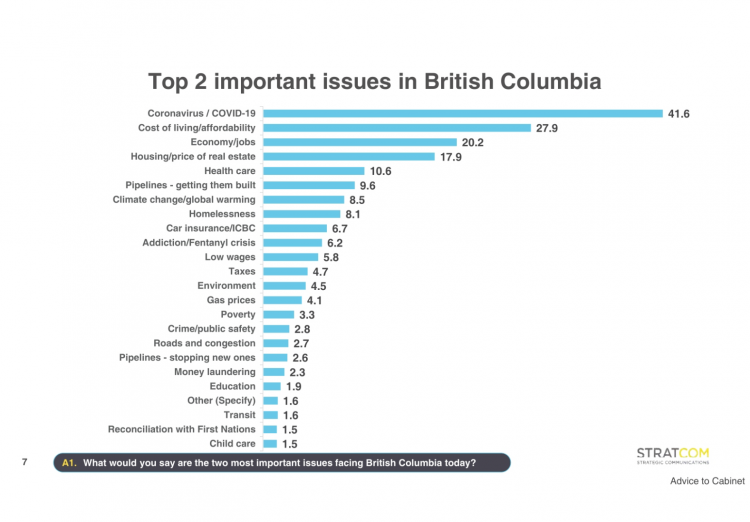
Stratcom also separated respondents by those who considered the NDP government on the right track versus those who thought the government was on the wrong track.
“Just under three-quarters (72 per cent) think the B.C. government is on the right track. As can be seen in the tracking charts over time, this is a rating considerably higher than the norm (pre-2020 data points).”
Stratcom also found the B.C. government ranked highest in satisfaction among three governments (85 per cent versus 77 per cent federal and 68 per cent local).
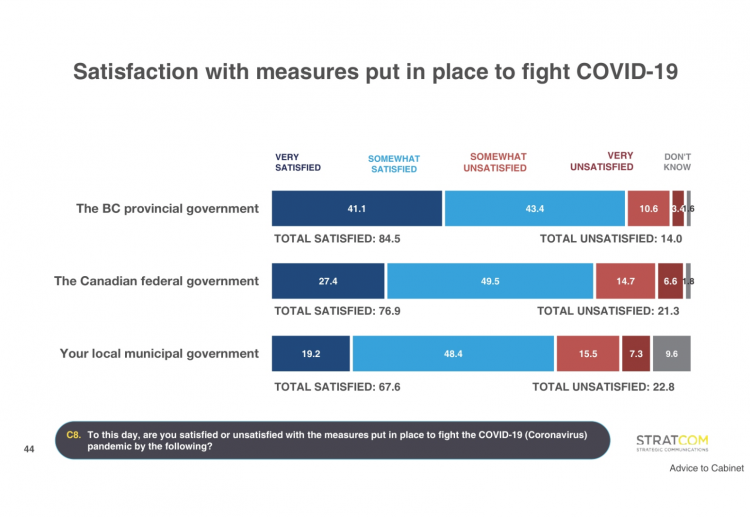
The finding was a very good sign for the NDP, which was scheduled to go to voters in October 2021 but shifted gears in the summer of 2020 when virus infections waned and public health restrictions relaxed.
So-called right-track voters supported the government’s work on COVID-19, cost of living, economy/jobs and climate change/global warming. Wrong-track voters were unhappy with the NDP’s handling of housing, health care, getting pipelines built, homelessness, car insurance and the opioid crisis.
People over 55 were more likely to think the government was on the right track, most likely to think the government was doing an excellent job handling the pandemic (+12 per cent) and most likely to think that COVID-19 is a real threat (+5 per cent).
That was another good sign for the NDP, because the over-55 set is also the age bracket that traditionally tends to vote more than the rest.
The choice to feature Health Minister Adrian Dix and Provincial Health Officer Dr. Bonnie Henry as spokespeople for the battle against the virus, rather than Horgan, was supported by the vast majority of respondents. They agreed the government was providing very clear (54 per cent) or somewhat clear (32 per cent) information about the pandemic. Those aged 65 and up were especially pleased: 75 per cent scored the government’s communications as very clear.
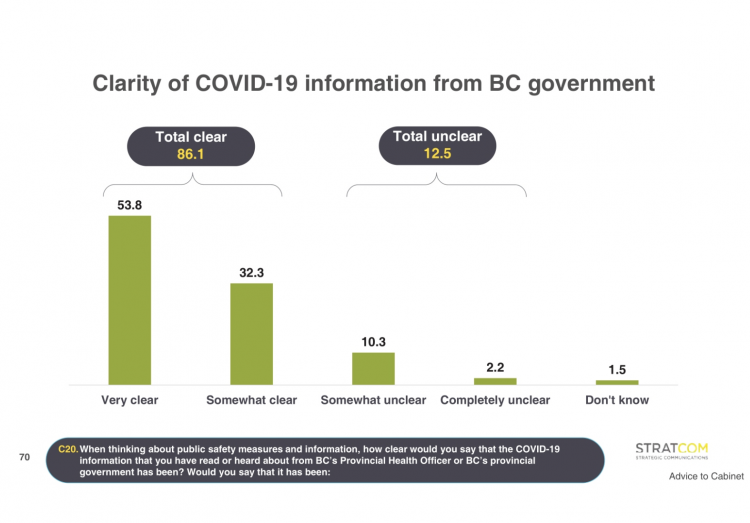
Some 77 per cent considered COVID-19 a real threat, versus only 14 per cent who believed it was blown out of proportion and nine per cent who said they were not sure. Residents outside the Lower Mainland and Vancouver Island were more likely to not see COVID-19 as a real threat.
“Those who think the B.C. government is on the wrong track are more likely to believe COVID-19 is blown out of proportion (25 per cent).”
A plurality (38 per cent) believed it would be more than a year before day-to-day life returned to normal. The biggest beef was not being able to travel (50 per cent) followed by concerns about a loved one getting sick (48 per cent) and personally getting sick (41 per cent).
The survey focused heavily on economic questions. It undoubtedly informed not only the May 6, 2020 announcement of B.C.’s Restart Plan, but the StrongerBC economic blueprint timed for rollout just four days before Horgan’s snap election call.
Over half (53 per cent) rated the economy fair, 32 per cent good and two per cent excellent. Vancouver Islanders were more likely to rate the economy good (37 per cent) and gave the government an excellent rating for its handling of the pandemic (44 per cent). The numbers were a turnaround from early days when businesses big and small ground to a halt.
“The proportion rating the economy as poor increased more than two-fold in the first weeks of the pandemic but this has been gradually dropping since mid-May and is now only a few points above November 2019 figures.”
Two-thirds rated the government’s job of handling the pandemic as either excellent (32 per cent) or good (42 per cent), and a majority (72 per cent) was optimistic about B.C.’s future – 18 per cent better than November 2019.
Only 15 per cent of respondents said they lost their job due to the pandemic, though almost one-quarter (22 per cent) said a family member lost their job and more than one-third (36 per cent) knew someone outside their family who lost their job. Those 18-34 were most likely to have lost a job due to pandemic (+10 per cent).
A majority (65 per cent) believed the restart plan measures properly balanced health and economy, but 24 per cent worried the distancing measures were being relaxed too quickly.
The most divisive questions were about reopening schools and protecting transit schedules.
On the education question, “the opinion of those with kids under 18 in their household (25 per cent oppose, 23 per cent support) does not vary from the opinion of those without kids (24 per cent oppose, 23 per cent support).”
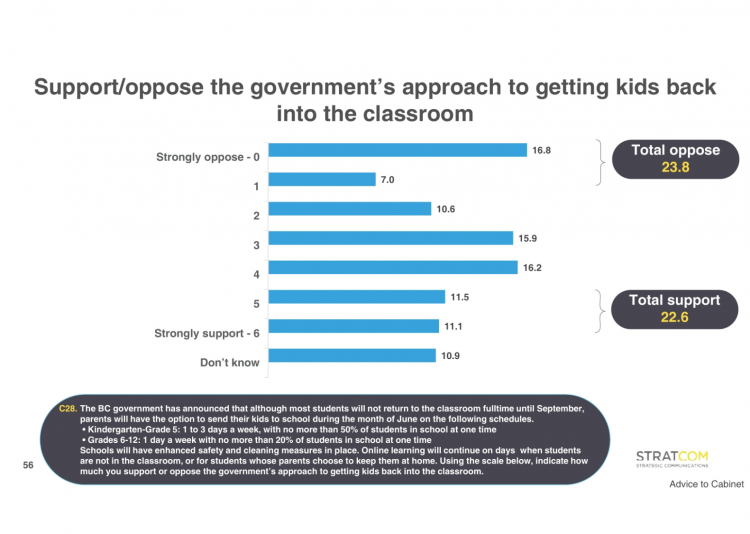
For buses and trains, 42 per cent opposed service cuts and 42 per cent thought cutbacks and layoffs made sense as white collar work-from-home conditions prevailed.
More than two-thirds (67 per cent) of respondents favoured bailing out businesses to help workers keep their jobs and companies keep their doors open.
Looking forward to the end of the pandemic, respondents wanted the government to favour health care, manufacturing and jobs.
“The priority with the most No. 1 ranks is: Making sure B.C.’s health-care system is ready for another pandemic so that B.C. is never again hit so hard,” the report said. “The priority with the most ranks overall, and second most No. 1 ranks, is: Improving health care and ensuring our doctors and nurses always have the resources and equipment they need.”
Less than three weeks before election day, on Oct. 6, 2020, Horgan released the NDP platform, built around four main themes: Fighting a pandemic, better health care, affordability and security, and good jobs and livelihoods in a clean-energy future.
All of these were explored in the Stratcom polls.
Eight months after the election – and a year after Stratcom’s daily tracking polling – the BC Liberals grilled the NDP during budget estimates hearings at the legislature.
Peace River MLA Mike Bernier elicited a vague answer from Dix on June 15, 2021, suggesting he would be “happy to look into polling that may have taken place.”
Then-Minister of Finance Selina Robinson, whose portfolio included GCPE, was more candid with Bernier. She said that polling was helpful to identify the challenges and needs of citizens, communities and businesses “so that we could get through this pandemic.”
The next day, it was then-interim Opposition leader Shirley Bond’s turn. But Horgan predictably and coyly denied that he used Stratcom’s polling for political gain.
“StrongerBC was the government’s plan,” he said. “It was not the NDP platform. How it was characterized is not something I had any control over. The polling that is done regularly by government informs the creation of policies and programs.”
Ultimately, it helped Horgan win an election and has given successor Eby the chance to keep power in NDP hands.
This is the first article in a two-part series on the NDP’s use of polling ahead of the snap October 2020 provincial election. Read part two here.

